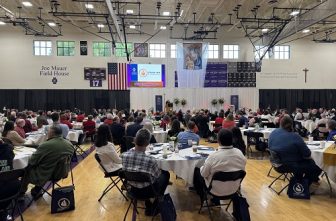This is confirmation season. While some of our candidates receive this great sacrament in the fall or winter, the vast majority of young people within the Archdiocese of St. Paul and Minneapolis receive the sacrament in the weeks and months right after Easter. It’s a very, very busy time for our bishops, as well as for the Cathedral of St. Paul in St. Paul and the Basilica of St. Mary in Minneapolis.
Confirmation cannot be understood apart from baptism. Indeed, confirmation takes its name not from the personal assent of the one being confirmed (as in, “I confirm my choice to be Catholic,” or “I confirm my faith in Jesus Christ”) but rather from the confirmation of baptismal grace, which most of us receive as infants. Because of the age at which most of us receive confirmation nowadays, mid-adolescence, it is easy to assume that the sacrament is like many of the other events in our young life at that time — a time of transition to adulthood when more serious duties are assumed. But this misunderstanding is largely a consequence of the current widespread timing of the conferral of confirmation, which has been shaped and molded by many different factors throughout the years, including the lowering of first Communion age by St. Pius X over a century ago. Keep in mind that the confirmation of infants is still the practice of the Eastern Churches.
Rather than a graduation or personal affirmation of faith ceremony, the sacrament of confirmation seals and strengthens the gifts of grace given in baptism, which includes the powerful gift of the Holy Spirit, who dwells within the souls of all the baptized in a state of grace. Just as the Apostles received the life-changing message of the Resurrection on Easter but still required the gift of the Holy Spirit on Pentecost to proclaim that message boldly, so too we need both the saving waters of baptism and the compelling fire of the Holy Spirit. Easter and Pentecost are inextricably connected.
On the façade of our world-renowned Cathedral are found the two greatest of Apostles, Peter and Paul. I’d like to suggest that these two figures represent the sacraments of baptism (Peter) and confirmation (Paul) and therefore the two great directions of the Church — communion (Peter) and mission (Paul). Baptism makes us a member of the body of Christ, joined to the mystical and hierarchical Church. Peter and his successors stand at the visible center of that communion. Without Peter there is no lasting unity. A man of frailty and self-diagnosed sinfulness, Peter was nevertheless chosen by Christ to “strengthen his brethren in the faith.” Not every pope has been a saint. But every pope has been given a divinely appointed task to preserve the unity of the Church, which has baptism as its sacramental beginning.
But it is not enough for the Church to simply preserve unity. She is also called to go out to all the nations and proclaim the good news. This is a particularly Pauline vocation. Paul came to realize, after his union with Peter had been secured through repentance and baptism, that he had been given the mission to make Jesus Christ known and loved by the Gentiles. And so, the Church continues to follow this great missionary’s example, by boldly proclaiming to all people that “Jesus Christ is Lord.” In confirmation, we are given the power to do just this — to witness before the world the wondrous things the Lord has done and to call all peoples to the saving waters of Christian faith.
At times, these two dynamics within the Church can seem to be in tension. How do we maintain doctrinal clarity, our liturgical traditions and our moral teachings, while also speaking language that the modern man and woman will understand and find compelling? How do we as a Church properly evaluate what is good in the world, while also remaining true to our history and most important memories? It’s not easy. It requires both Peter and Paul. Unity and mission. Baptism and confirmation.
Come Holy Spirit!
Father Erickson is parochial vicar of Nativity of Our Lord in St. Paul and interim chairman of the Archdiocesan Liturgical Commission.





